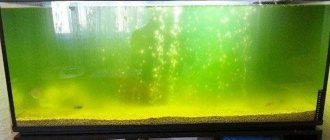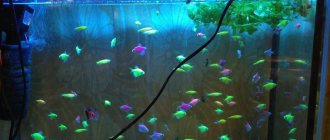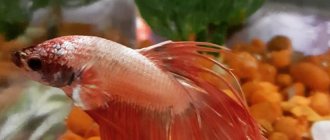How often should you clean your aquarium?
There are two determining factors on which the frequency of cleaning an artificial reservoir depends. The first of them is the volume of the vessel, and the second is the population density of the aquarium. You should also take into account the type of fish living in it. Most often, the aquarium is washed 1-2 times a week.
The density of vegetation in a glass container also affects how often clogs are cleared. The more vegetation there is in the aquarium, the less often it needs to be washed. Let's look at the main signs that signal that the time to wash the container has come:
- plaque on glass;
- plaque on plants and decorative elements;
- cloudiness of the water.
It is not difficult to clean the aquarium with your own hands, however, you should not deviate from the recommendations specified in the instructions. The use of any chemical reagents that are not specialized is strictly prohibited. This can lead to the death of the fish.
What happens when soil siphons?
In the soil, detritus with a fraction of 2-5 mm clogs the empty space and the environment becomes slightly anaerobic, which has a good effect on plant growth. Bacteria live on the surface of the soil and process organic residues. During siphoning, the upper part of the soil sinks down and nitrifying bacteria die. There are problems with nitrites and ammonia in the container. Nitrifying bacteria need time to recover.
During cleaning with a siphon, a lot of sludge gets into the water, the water becomes cloudy, which leads to the release of ammonium and organic matter into the water. This in turn leads to the appearance of filamentous algae, blackbeard or flip flops. Therefore, there is no need to overdo it with cleaning.
If there is a lot of dirt in the aquarium, then do not rush to restart and wash the soil. Every other day, siphon well a small area of the container, approximately 15-20% of the bottom area. In this case, keep the siphon in one place longer than usual. Remove plants from the soil and plant them again after cleaning.
Please note that biofiltration will decrease and will be restored after a day. To reduce the load on the aquarium, the fish are not fed that day, and the next day they are given less food than usual. To quickly restore balance, you can add a culture of beneficial bacteria to the water.
What is the best way to clean an aquarium yourself?
Proper cleaning of a glass tank is done using special equipment. Consider the list of accessories that are usually used for this work:
Aquarium cleaning equipment
- scraper;
- siphon;
- bucket;
- net
The scraper is used to remove plaque that forms on the inner surface of the glass walls during operation of the aquarium. To select a scraper, you should pay attention to its type and dimensions. Experts recommend using a professional magnetic scraper. It is very convenient to use. All you need to do is run the scraper along the outer wall and the dirt will be removed from the inside. But the disadvantage of such an accessory is its high cost. You can clean a cloudy glass aquarium with fish using simpler means.
Note! An alternative to a scraper is a regular sponge. But under no circumstances should you soak it with cleaning compounds.
A siphon is used to clean the soil at the bottom of a glass tank. The advantage of such a soil cleaner is that when using it there is no need to remove the soil from the aquarium.
Important! If you need to clean a glass tank without draining the water, then there is no particular need for a net. This accessory is used to safely remove your beloved pets from the container.
You can use baking soda to clean your aquarium. However, do not forget that the improvised cleaning agent must be thoroughly rinsed off after use.
Interesting: DIY bath pond
Tips for use
Experienced aquarists know well how to use a siphon, but beginners often have questions and difficulties. Therefore, we will give some tips regarding the first cleaning of the aquarium:
- The end of the hose must be lowered below the aquarium, only then the water will begin to drain.
- The lower the tip of the tube is lowered, the stronger the pressure will be.
- The deeper the funnel goes, the better the bottom will be cleaned. If there are no plants on the plots, then it is allowed to immerse it to the entire depth of the soil.
- A device that is too powerful can easily suck in fish, so pay close attention to the cleaning process.
- Special devices are sold for nano aquariums. The standard version will be too large and can easily harm pets. If you couldn’t find a suitable unit, you can make it yourself from a syringe and a dropper tube.
- When choosing a siphon, you need to consider the following points: the volume of the aquarium, the type of soil, the number of plants and decorations.
Follow these tips and cleaning your aquarium soil won't be too difficult for you.
How to properly clean an aquarium?
Cleaning the glass tank is carried out in several steps. It does not matter how large the artificial reservoir is. There is a strictly defined sequence for cleaning the aquarium that must be followed. Let's take a closer look at it.
First, the glass walls are cleaned. After removing the plaque consisting of algae and bacteria, you need to clean all decorative elements. Next, the rotted leaves of the plants are removed. Then, using a siphon, the soil is cleared of waste products of living organisms living in the aquarium. The next thing that is recommended to do is to partially drain the liquid. At the end, the filters are cleaned and the missing amount of water is added.
Note! When cleaning an old aquarium, you must remember that before starting the procedure, you should turn off all devices connected to electricity.
Before starting cleaning, it is also recommended to study the video, which describes the process more clearly. It is not necessary to remove fish from the aquarium while washing it. If the procedure is performed in compliance with all the rules, then they will not receive any harm.
Recommendations for choosing a siphon for an aquarium
Before purchasing a hose, measure its required length, and purchase a transparent hose, the internal diameter of which is 0.8 - 1.2 cm. The hose for the siphon should have a diameter slightly larger than the diameter of the pebbles in the aquarium, or be transparent in order to notice the formation in time congestion. It is worth considering that the thicker the tube, the greater the water flow. When buying a hose, pay attention to what material it is made of. Reinforced, corrugated and other reinforced structures are not suitable for an aquarium hose. It is better to buy a hose made of polyvinyl chloride, which is light, elastic and compact. Such a hose must be stored rolled up, without kinks, otherwise cracks may form in their place. Experienced aquarists advise using special brackets, brackets or clamps for the hose so that it is securely fixed and does not come off the drain spout. For this purpose, you can use a small piece of plastic pipe a couple of millimeters larger than the diameter of the drain hose. The scrap must be carefully bent and secured so that the drain hose is not compressed. The corrugated connection of the drain hose with a siphon for an aquarium is very convenient, since the hose does not get pinched when trying to clean the farthest corner of the aquarium or siphon the soil in a high aquarium.
It is very convenient if dirty water from the aquarium is drained directly into the bathroom drain pipe. To do this, you can install or use an existing V-shaped corner designed for draining dirty water from an automatic washing machine. If it is impossible to drain water from the aquarium into a special pipe, then you will have to install an adapter on the side of the bathtub or toilet to securely fix the hose.
However, most often aquarists use a regular bucket as a container to drain water from the aquarium. When water is poured, the siphon drain hose is completely lowered into it and filled with water. The free end of the drain hose is clamped with a finger, removed from the aquarium and lowered into a container (bucket), when the finger is removed, the water begins to flow by gravity. If you wish, you can adjust the speed of liquid flow in the siphon. To do this, near the junction of the siphon with the drain hose, it is necessary to make a hole in the tube equal in diameter to the cross-section of the tube itself. The intensity of the water flow can be adjusted by either opening or squeezing the hole made with your finger.
Another successful aquarium device that makes working with a siphon easier is a special fastener. Typically, the drain hose at the siphon is lowered into a container, usually a bucket. At the same time, the end of the hose tends to jump out of the bucket and flood the floor, so you have to support it with one hand. But with a high aquarium, this is inconvenient, since sometimes you need to use both hands to move the siphon along the bottom. It is in this case that fasteners will help out the aquarist. It is a plastic half-ring that is attached to the wall of the bucket. A hose is threaded through the fastener. In this case, the diameter of the drain hose may vary. If, for example, an aquarist wanted to lengthen the siphon hose, then he will have to use an additionally purchased hose of a larger diameter and when connecting two hoses, by inserting one into the other, the fasteners will allow him to hold this larger diameter hose. A drain hose secured in this way will certainly not be able to slip out of the bucket while both hands of the aquarist siphoning the soil are occupied.
There are models of siphons for aquariums that are equipped with a tap valve. Convenient accessory. If, for example, when cleaning the aquarium soil, dead roots (leaves) of plants stick to the protective grid of the lower part of the cylinder, or a fish accidentally swims in, then the siphon will not need to be pulled out to remove the debris. Simply turn the valve to shut off the water and, as the suction effect stops, the debris will fall off the grate. It is also convenient to use a faucet valve when dirty aquarium water has completely filled the drainage container - it shuts off the flow of water and there is no need to remove the siphon from the aquarium. You can safely go and pour out the dirty water to free up the container for the next portion of liquid to be drained.
Cleaning the walls
Contamination of glass with bacteria and algae is a natural process, so you should not think that the problem is due to improper fish keeping. Glass that becomes cloudy over time causes discomfort not only to the inhabitants of the aquarium, but also prevents owners from monitoring the lives of their beloved pets.
To remove plaque from the walls, you need to purchase a special scraper. A simpler option involves using a regular sponge, which can be found in every person’s home. When using a magnetic scraper, please note that it does not cope well with dirt in the corners of the aquarium. You can also wash the outside of the glass container. On sale you can find special products adapted for this purpose.
What types of aquarium siphons are there?
Siphons for cleaning aquariums differ from each other in size, funnel shape, and method of water suction.
The siphon should be selected based on the size of the aquarium. There are models for high capacities, standard and very small.
The cross-sectional shape of the funnels is round and with one right angle for cleaning at the corners of the container, and the rest is round. To clean the space between snags and stones, narrow siphons are used.
There are models in which the flow of water is created using a pear, as well as a sharp lowering and raising of the cylinder. Siphons with a pear are more convenient to use, but are short-lived.
There are electric siphons that run on batteries. They can suck water from a container and immediately drain it into the sewer. Or they can clean it and return it back to the aquarium. Such models are good for containers where the soil is heavily contaminated, and too large changes cannot be made.
We process plants
Artificial water tanks designed to house fish almost always contain a large amount of vegetation. Plant waste products are one of the causes of aquarium clogging. Rotten leaves settle to the bottom and accumulate if they are not removed for a long time. This promotes the proliferation of pathogenic microorganisms.
Note! It is not recommended to transplant plants to another place if they have been located in another area of the aquarium for a long time. You should also remember that spoiled leaves must be removed immediately.
Some plants can grow significantly over time. It is recommended to remove them, as they make it difficult for fish to move freely inside the glass tank.
Interesting: How to build a gazebo at your dacha with your own hands
Caring for the bottom of an aquarium using a siphon
In order to clean a glass container with water, there is no better device than a siphon, which consists of a tube and a pump. There is a tip at the end of the tube of this accessory. It is used to lift the soil and remove waste products of fish and plants.
The soil needs to be cleaned less frequently than routine cleaning. During general cleaning of a glass aquarium, not only the soil is cleaned, but also the sand. The sand is cleaned using a tube. After this procedure, the siphon should be thoroughly rinsed.
Siphon cleaning
What happens under ideal conditions?
A natural ecosystem involves a large number of participants. The remaining fish food is eaten by shrimp and snails. Rotten plants and small uneaten food residues are processed by protozoa bacteria. Next, plants with strong root systems consume the organic matter they need to grow.
It is not always possible to create such conditions in home aquariums. Imagine a container with cichlids. There will be no plants or shrimp there. Accordingly, there will be no one to eat the leftover food; the leftover food and fish waste products will accumulate in the ground. This is where you will need a siphon.











